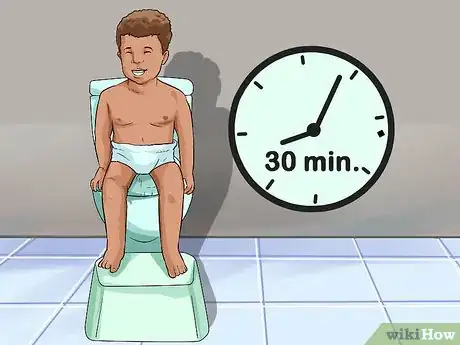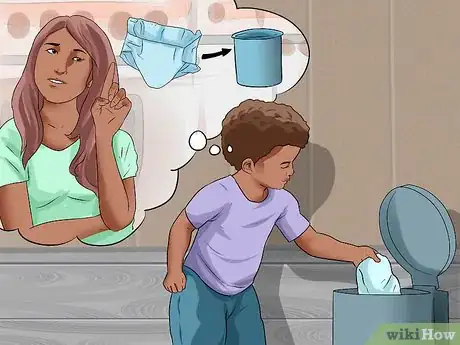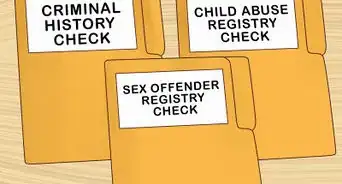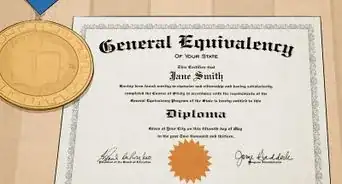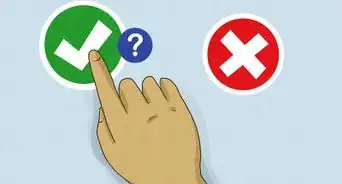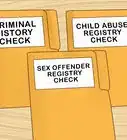This article was co-authored by Sylvia Rath. Sylvia Rath is a Parenting Specialist and the Director of Little Village Nursery School in Los Angeles, California. With over 30 years of experience, Sylvia guides parents through the preschool years and beyond by teaching respectful communication and positive discipline methods. Sylvia holds a BA in Psychology and Early Child Development from Antioch University. Before working at Little Village Nursery School, she taught preschool for eight years.
There are 22 references cited in this article, which can be found at the bottom of the page.
This article has been viewed 74,014 times.
Preparing your child for nursery school can be a challenge, but it does not have to be daunting. You can do things to help your child get ready. However, you should be aware that every child develops at their own pace, and it is important to recognize and honor the readiness of your child and not push your agenda unreasonably. A good place to start getting your child ready for school is with potty training.
Steps
Preparing Your Child Physically
-
1Work on potty training. Some schools expect your child to be at least partially potty trained, especially if your child is 4-years-old or older. If your child is younger, your child may not need to be completely potty trained, however you and your child should be working on it together.[1]
- Wait patiently for your child to be ready. Your child should start showing an interest in the toilet before you begin potty training.[2] This will usually be about the age of 2 or 2½. Your child should also be able to understand directions and stay dry for about 2 hours at a time. To increase success, make sure that your child can communicate and wants to be clean and dry. Coming to you when he/she needs a change is a wonderful readiness skill. Your child should also know: up and down, clean and dirty, and wet and dry. They should know the names of their body parts and the potty terminology used in your house, for example, pee and poop. [3]
- Get tools to help you potty train. It's difficult for your child to use a regular-sized toilet without any adaptations. You can either get your child a small toilet that is their size, or you can invest in a smaller child-sized toilet seat that fits over your regular one.[4] You may also want to get a stool that your child can use to reach the toilet, or to reach the sink when washing their hands after using the toilet.
- You can also try switching to underwear or training pants. A lot of preschools will appreciate it if your child wears disposable training pants because they are easy to clean up after accidents and the child can pull them up and down making it easier to use the toilet. [5] In fact, letting your kid pick out underwear or training pants can help get your child excited about the process. It's also important to have clothes that your child can get off easily.
-
2Establish a schedule for bathroom breaks. Try to take regular bathroom breaks every couple of hours or so throughout the day.[6] During these breaks, have your child try sitting on the potty without a diaper. Both boys and girls should be sitting down at first, even though boys will move to standing up and peeing in a urinal later.[7]
- Try having them sit on the toilet about half an hour after eating. You should also encourage your child to take a break when they look like they need to go. They may wiggle around or grab at their crotch area, for instance.
- Get your kid to the bathroom as soon as you notice the signs. If your they end up going in the potty, make sure to show your excitement so they get the idea. Letting your kid flush the toilet can also be a fun reward for some kids.
- Rewards can be helpful, too. You can use whatever incentive your child enjoys, such as stickers or even reading time with a parent or sibling. Give your child a reward every time they go potty in the toilet.[8]
Advertisement -
3Practice dressing skills. Of course, your child's teacher will help when your child needs a zipper done up or shoes tied, but the teacher only has so much time. The more your child can do by themselves, the better. Try to make learning dressing skills a game. For example, you could have your child see how fast they can dress themselves and tie their shoes, then see if they can beat their time. Remember to show excitement for skills they've done well.[9]
- Ask your child’s teacher what type of shoes they prefer the children to wear and teach your child to put on and take off shoes by themselves.
- Let your child practice shoe tying with a string attached to a board.
- Show older children how to lower and raise their pants, waistbands, or zippers independently when using the bathroom.
- You also find toys which help your child work on buttons, zippers, and Velcro.
- Most children 3 and up can be taught how to put their coat on by themselves. Try laying the jacket flat in front of the child, facing away from them. Have them put their hands in the sleeves and flip the jacket over their head.[10]
-
4Work on a single nap. Most preschoolers only take 1 nap in the afternoon. The rest of the day, the kids are busy doing activities. Ask the school what time the children take a nap so you can adjust your child’s schedule accordingly. If your child still takes 2 naps, try keeping the child up through the morning, then let them sleep more in the afternoon.[11]
- Try keeping your kid engaged and very active in the morning. Play outside or choose an activity that's physical instead of choosing a quieter activity like watching a movie. That way, they won't want to sleep in the morning, and they'll be tired out by the afternoon.
- Ask the school what the children will nap on (like a cot, a mat, or in a crib). Have your child practice napping on a similar surface at home.[12]
- Also, ask the school what items are permitted during nap time. Some schools may not allow the children to have comfort objects, like a pacifier, stuffed animal, or lovey.
-
5Practice independent eating. Your nursery school will likely encourage independent eating for lunch, breakfast and snacks. Ask your child’s nursery school what meals are served when and try your best to emulate these mealtimes in your home in the weeks leading up to your child’s start in school so their body adjusts to expecting meals at these times.
- Have your child work on feeding themselves during meal time. Younger children may use their fingers to eat. Three and four year olds should use spoons or forks. Practice using a cup with your child as well.[13]
- Practice “family style dining” at home. This is when food is served in big bowls and drinks are served in pitchers on a family table. Invite your child to use ladles to serve themselves food and to pour their drink into their cup from a pitcher. Nursery schools often work to teach your child to eat “family style”.[14]
- In school, children will be expected to be a part of the mealtime clean up process. Have your child clean their plates up independently by having a child-size trash can where they can throw excess food. Ask your child’s nursery school if they will be using paper plates and cups or if they should bring in a set from home. Teach your child that paper paper plates and cups are thrown out and at home, their plates and cups are washed in the sink for reuse.[15]
Working on Appropriate Skills
-
1Encourage independence. Once your child enters nursery school, they should be able to play for at least a short period of time by themselves or with other kids. They can't need to be constantly told what to do by an adult because preschool consists of some independent play with a large group of kids.[16]
- As your child gets to nursery school age, at age 3 or 4, try encouraging your child to play independently.
- When your child is bored and wants to play, ask them what they'd like to do. When they name it, help them get it out, and walk away to let them play. If they ask you to play with them, let them know that you'd like them to play by themselves for a little while.
-
2Help your child play with others. The best way to help your child develop social skills is to plan play dates and put them in other situations where they interact with other kids, such as at the playground. You can also enroll your child in parks and recreation class to interact with other kids in a more structured setting.[17]
- You can also help your kid learn social skills by playacting conversations with them. For example, you could pretend to be one of your child's friends and playact a conversation your child may have with another child.
- Try focusing play dates around activities your child enjoys or is interested in. That way, they are more likely to interact with the other kids.[18]
- Practice sharing and taking turns with your child. When playing with your child at home, play turn-taking games and practice sharing by asking to play with your child’s toys and having them practice asking you verbally to play with toys that you are playing with.[19]
-
3Read to your child. Reading to your child introduces them to books and reading, which gets them on the road to school. Plus, reading to your child teaches them to sit still for a period of time, which is also an important skill for school.[20]
- As you get closer to preschool, pick up some books about going to school. That can help introduce the topic to your child, giving them a chance to talk about their thoughts and emotions.
-
4Work on listening skills. Your child will need to be able to listen to instructions because that's the only way a teacher has of corralling a class of kids. Work on giving your kid directions and having them follow through, such as when they're brushing their teeth. You can also try fun activities like baking together where you tell them what they need to do.[21]
- If your child doesn’t listen, walk away and say, “It seems like you don’t want to listen right now. When you’re ready to listen, please come and get me so we can talk nicely.”[22]
- Games can also help encourage listening, such as I, Spy, Simon Says, Mother, May I?, and Red Light, Green Light.
- Older children can work on multi-step directions.[23]
-
5Encourage creativity. Encouraging your kid's artistic side is not only fun for both of you, it helps develop fine and gross motor skills, which is important for starting school. Coloring, painting, sculpting, and drawing all help your kid work on those skills, and they'll have fun doing it.[24]
- Try working on art activities together. Your kid will be even more enthusiastic about art if you get to spend time together.
- If art isn't your kid's thing, try other activities that build motor skills, such as using building blocks or putting puzzles together. You could also try practicing some basic cooking skills.
-
6Improve communication. When your child is at school, they need to be able to tell their teacher when they need things, like going to the bathroom. They don't need to speak perfect English, but they should be able to able to communicate with other adults.[25]
- One way to encourage communication is to not immediately fill your kids' needs. That is, you may already know what your kid wants before they ask. However, make them ask for what they need before you give it to them. That will encourage them to be more communicative.
- You can also model behavior by vocalizing needs you have. If your kid sees you asking for what you need, it will help them learn that behavior, as well.
Making School Less Scary
-
1Give your child a verbal preview. In the days leading up to nursery school, talk to your child about what will happen at school. You can tell your child where they'll be going, what they'll be doing during the day, and what will be expected of them. Try to keep it as light and fun-sounding as possible, but let your child express their fears. Try to answer any questions they have honestly and openly.[26]
- For example, you could say things like, "In a few weeks, you'll be going to nursery school. Nursery school is when you go to a place where there are other kids. You'll get to play and listen to stories. Mommy and Daddy won't be there, but you'll have another adult called a teacher looking after you, like when you go to daycare. Does that sound like fun?"
- Remind your child that going to school isn't scary, and that they're going to have fun.[27]
-
2Work on separation. If the first time your kid has ever been away from you or other family members is nursery school, it can make the process that much scarier. To help take some of the sting away, practice the separation by asking a friend to babysit for you.[28]
- Start with shorter periods away, such as 30 minutes, and work up to longer periods.
- Tell your child you're going to leave, but that you'll be back soon. When you come back, you're proving to your child that you'll do what you say.
- If your child doesn't stop crying the whole time you're gone after several sessions, they may not be ready to go to nursery school yet.[29]
-
3Attend an open house. Most schools have open houses where you and your child can see the school. Seeing the school ahead of time helps you prepare your child for going there. Plus, letting your child see the classroom can get them excited about going to school, as it will probably be bright and colorful with toys and books.[30]
- Another way to help ease your child into nursery school is to have your child meet the teacher. That way, your child will be able to see how nice the teacher is, and they'll have a friendly, familiar face on the first day of school.[31]
-
4Walk past the school at recess. While school is in session, trying take your kid by the school so he or she can see the other kids playing. Seeing the fun they're having will help your child be more comfortable with the idea of going to school.
-
5Encourage enthusiasm. Whenever you're talking about school, talk about how fun and exciting it will be. If your child sees you're enthusiastic, they'll be enthusiastic, too. Keep the enthusiasm up even when you're taking your kid to school for the first time. If you're upset and anxious, it will rub off on your child, while if you stay excited, it will likely be easier on them the first time.[32]
-
6Give your child choices. Another way to encourage enthusiasm is to let your kid pick out school supplies in anticipation of school. Obviously, the school will have some required supplies, but letting your kid pick out their lunchbox, backpack, and even new school clothes can make them more excited.
- Another way to give your child choices is to let them pick out things for school in the morning. For instance, you can let them choose their outfit, as well as their snack or lunch.
Expert Q&A
-
QuestionWhat should my child be able to do before starting nursery?
 Courtney CoprivizaCourtney Copriviza is an Elementary School Teacher based in Maui, HI. Courtney specializes in elementary education, classroom management, and social and emotional development. She holds a BA in Communication with a minor in Urban Education and an MA in Teaching from Santa Clara University. Courtney has also taught high school in Madrid, Spain. She is a member of Kappa Delta Pi International Honors Society in Education.
Courtney CoprivizaCourtney Copriviza is an Elementary School Teacher based in Maui, HI. Courtney specializes in elementary education, classroom management, and social and emotional development. She holds a BA in Communication with a minor in Urban Education and an MA in Teaching from Santa Clara University. Courtney has also taught high school in Madrid, Spain. She is a member of Kappa Delta Pi International Honors Society in Education.
Elementary School Teacher Review some basic things that your child might learn in kindergarten, like ABCs, basic reading, number recognition, and simple counting.
Review some basic things that your child might learn in kindergarten, like ABCs, basic reading, number recognition, and simple counting. -
QuestionWhat do you do when your child refuses to attend nursery school?
 Courtney CoprivizaCourtney Copriviza is an Elementary School Teacher based in Maui, HI. Courtney specializes in elementary education, classroom management, and social and emotional development. She holds a BA in Communication with a minor in Urban Education and an MA in Teaching from Santa Clara University. Courtney has also taught high school in Madrid, Spain. She is a member of Kappa Delta Pi International Honors Society in Education.
Courtney CoprivizaCourtney Copriviza is an Elementary School Teacher based in Maui, HI. Courtney specializes in elementary education, classroom management, and social and emotional development. She holds a BA in Communication with a minor in Urban Education and an MA in Teaching from Santa Clara University. Courtney has also taught high school in Madrid, Spain. She is a member of Kappa Delta Pi International Honors Society in Education.
Elementary School Teacher Try to get them excited about nursery school instead. Remind them that nursery school is fun, and that they'll have a great time when they go.
Try to get them excited about nursery school instead. Remind them that nursery school is fun, and that they'll have a great time when they go.
References
- ↑ https://www.understood.org/en/learning-attention-issues/signs-symptoms/academic-readiness/how-to-know-if-your-child-is-ready-for-preschool
- ↑ Sylvia Rath. Parenting Specialist. Expert Interview. 19 May 2021.
- ↑ https://www.understood.org/en/learning-attention-issues/signs-symptoms/academic-readiness/how-to-know-if-your-child-is-ready-for-preschool
- ↑ http://kidshealth.org/en/parents/toilet-teaching.html#
- ↑ http://www.mayoclinic.org/healthy-lifestyle/infant-and-toddler-health/in-depth/potty-training/art-20045230
- ↑ Sylvia Rath. Parenting Specialist. Expert Interview. 19 May 2021.
- ↑ http://www.mayoclinic.org/healthy-lifestyle/infant-and-toddler-health/in-depth/potty-training/art-20045230
- ↑ http://kidshealth.org/en/parents/toilet-teaching.html#
- ↑ http://www.notimeforflashcards.com/2013/07/simple-ways-to-get-your-child-ready-for-school.html
- ↑ https://web.kidsactivitiesblog.com/58500/kid-hacks
- ↑ https://www.understood.org/en/learning-attention-issues/signs-symptoms/academic-readiness/how-to-know-if-your-child-is-ready-for-preschool
- ↑ https://www.whattoexpect.com/toddler/sleep/toddler-safe-sleep-practices/
- ↑ http://articles.extension.org/pages/26436/ways-to-encourage-self-help-skills-in-children
- ↑ https://healthykidshealthyfuture.org/links/tips-for-family-style-dining/
- ↑ https://kidsandcompany.com/blog/tidy-up-time-the-importance-of-cleaning-up-their-own-mess/
- ↑ https://www.understood.org/en/learning-attention-issues/signs-symptoms/academic-readiness/how-to-know-if-your-child-is-ready-for-preschool
- ↑ http://www.babycenter.com/0_how-to-prepare-your-child-for-preschool_64536.bc
- ↑ http://www.friendshipcircle.org/blog/2012/11/27/13-ways-to-enhance-your-childs-social-skills-and-make-friends/
- ↑ http://raisingchildren.net.au/articles/sharing.html
- ↑ http://www.notimeforflashcards.com/2013/07/simple-ways-to-get-your-child-ready-for-school.html
- ↑ http://www.babycenter.com/0_how-to-prepare-your-child-for-preschool_64536.bc?page=2
- ↑ Sylvia Rath. Parenting Specialist. Expert Interview. 19 May 2021.
- ↑ https://www.growinghandsonkids.com/tips-for-following-directions-in-the-classroom-home.html
- ↑ http://www.babycenter.com/0_how-to-prepare-your-child-for-preschool_64536.bc?page=2
- ↑ https://www.understood.org/en/learning-attention-issues/signs-symptoms/academic-readiness/how-to-know-if-your-child-is-ready-for-preschool
- ↑ http://www.babycenter.com/0_how-to-prepare-your-child-for-preschool_64536.bc
- ↑ Courtney Copriviza. Elementary School Teacher. Expert Interview. 18 June 2021.
- ↑ http://handsonaswegrow.com/8-ways-to-prepare-your-child-for-preschool/
- ↑ https://www.understood.org/en/learning-attention-issues/signs-symptoms/academic-readiness/how-to-know-if-your-child-is-ready-for-preschool
- ↑ http://handsonaswegrow.com/8-ways-to-prepare-your-child-for-preschool/
- ↑ http://handsonaswegrow.com/8-ways-to-prepare-your-child-for-preschool/
- ↑ http://handsonaswegrow.com/8-ways-to-prepare-your-child-for-preschool/


